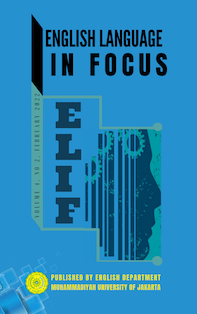The ESP Students' Satisfaction toward the Use of Duolingo Application in English Language Learning
DOI:
https://doi.org/10.24853/elif.4.2.163-170Keywords:
ESP students, students’ satisfaction, Duolingo ApplicationAbstract
Technology has contributed a spectacular impact on the learning system during the pandemic. Therefore, this research investigated The ESP students' satisfaction toward the use of Duolingo Application in English Language Learning. The participants were 109 ESP students in Accounting Study Program. Researchers had 12 statements in the questionnaire where the researcher find student satisfaction. This research has proved the students are very satisfied with Duolingo application. Based on the result of the questionnaire be diffused this study, most of the students (80%) are assumed that Duolingo Application has the great sound in its feature. Moreover, English Language Online Learning could be very interesting when the facilities are able to be fulfilled.References
AbuSa'aleek, A. O. (2014). A review of emerging technologies: Mobile assisted language learning (MALL). Asian Journal of Education and e-learning, 2(6).
Efriana, L. (2021). Problems of Online Learning during Covid-19 Pandemic in EFL Classroom and the Solution. JELITA, 38-47.
Garcia, I. (2013). Learning a language for free while translating the web. does duolingo work?. International Journal of English Linguistics, 3(1), 19.
Heift, T. & Chapelle, C. A. (2012) Language learning through technology. In Gass, S. M. & Mackey, A. (eds.), The Routledge handbook of second language acquisition. Abingdon: Routledge, 555–569.
Hulme, M. (2009). Why we disagree about climate change: Understanding controversy, inaction and opportunity. Cambridge University Press.
Huynh, D., Zuo, L., & Iida, H. (2016, December). Analyzing gamification of “Duolingo” with focus on its course structure. In International Conference on Games and Learning Alliance (pp. 268-277). Springer, Cham.
Loewen, S., Crowther, D., Isbell, D. R., Kim, K. M., Maloney, J., Miller, Z. F., &
Munday, P. (2016). The case for using DUOLINGO as part of the language classroom experience. RIED: revista iberoamericana de educación a distancia, 19(1), 83-101.
Nushi, M., & Eqbali, M. H. (2018). 50languages: A mobile language learning application (App Review). Teaching English with Technology, 18(1), 93-104.
Plonsky, L. & Ziegler, N. (2016) The CALL-SLA interface: Insights from a second-order synthesis. Language Learning & Teaching, 20(2): 17–37
Radin, J. (2017). Mobile assisted language learning: advantages and use among different age groups [articol].
Rawal, H. (2019). Mobile-assisted language learning: A Duolingo case study. ReCALL, 31(3), 293-311.Saputra, F, Rahman, M., & Firdiansyah (2019). The Classroom Interaction Between A Teacher And The Tenth Grade Students At Sma Al-Falah Islam Jambi (Doctoral dissertation, UIN Sulthan Thaha Saifuddin).
Smith, C. (2018) 17 amazing Duolingo facts and statistics (April 2018). https://expandedramblings.com/index.php/duolingofacts-statistics/
Tafazoli, D., Gómez Parra, M., & Huertas Abril, C. A. (2018). A cross-cultural study on the attitudes of English language students towards Computer-Assisted Language Learning. Teaching English with Technology, 18(2), 34-68.
Vesselinov, R. & Grego, J. (2012) Duolingo effectiveness study: Final report. Queens College, City University of New York.
Von Ahn, L. (2013, March). Duolingo: learn a language for free while helping to translate the web. In Proceedings of the 2013 international conference on Intelligent user interfaces (pp. 1-2).
Published
Issue
Section
License
Authors who publish with this journal agree to the following terms:
- Authors retain copyright and grant the journal right of first publication with the work simultaneously licensed under a Creative Commons Attribution License that allows others to share the work with an acknowledgment of the work's authorship and initial publication in this journal.
- Authors can enter into separate, additional contractual arrangements for the non-exclusive distribution of the journal's published version of the work (e.g., post it to an institutional repository or publish it in a book), with an acknowledgment of its initial publication in this journal.
- Authors are permitted and encouraged to post their work online (e.g., in institutional repositories or on their website) before and during the submission process, as it can lead to productive exchanges, as well as earlier and greater citation of published work (See The Effect of Open Access).


